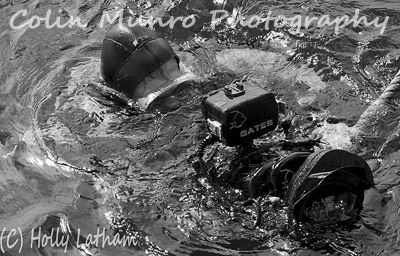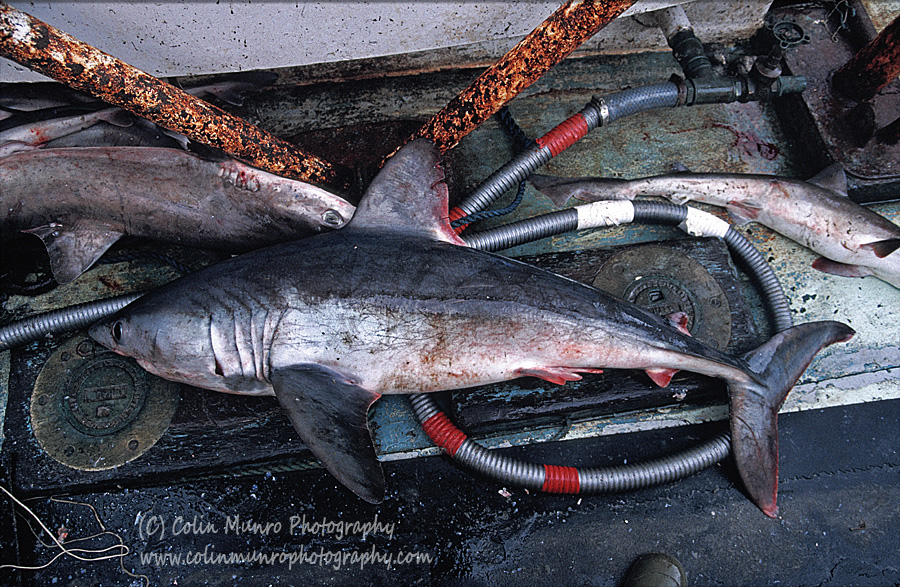Porbeagle sharks (Lamna nasus) are a temperate water species of shark belong to the mackerel shark family (Lamnidae), the same family as salmon sharks, makos and great whites. Adults are around 2.5 metres long and and weigh about 140kg. They are considered vulnerable throughout their range. The population around UK shores (NE Atlantic) is considered critically endangered (IUCN). The International Committee for Exploration of the Seas (ICES) advises that the NE Atlantic stocks may be close to collapse. A quota system for porbeagles was introduced in 2008. The Total Allowable Catch (TAC) was reduced to 436 tonnes in 2009. In UK waters a total ban on targetted fishing by commercial fishermen has been in place since 2010, with release of accidental bycatch whenever possible. ICES has called for a zero TAC since 2006; there are now proposals to bring this in to effect throughout the EU.
There is a still a problem in that porbeagles, are fast swimming predators that feed on squid and fish. Freuqently the species that fishermen are also targetting. Porbeagles may end up as accidental bycatch in trawls or in set nets. Like other mackerel sharks, porbeagles’ gills work by obligate ram ventilation. This means they need a constant flow of water past their gills in order to oxygenate their blood. Trapped in nets they quickly drown. As set nets are often deployed on the seabed then hauled 12 or 24 hours later, even if the fishermen would like to release them alive it will be too late. The Centre for Environment, Fisheries and Aquaculture Science (CEFAS) is currently conducting a DEFRA commissioned study in to the threats posed by accidental bycatch to porbeagle in UK waters. Hopefully this will result in guidance for fishermen as to the best ways to minimise the risk of accidentally catching porbeagles.
Save our Seas is working with the Marine Institute in Ireland to satellite tag porbeagles. This should help us understand portbeagle migration and possibly identify nursey areas. This has so far shown that porbeagles tagged off northern coast of Ireland have resurfaced off Lisbon, Portugal. Details of the study can be seen here.
Interesting fact: All fish are cold blooded right? Not quite. Recent studies have found that most mackerel sharks (salmon sharks, great whites, shortfin mako and porbeagles) are able to maintain their body temperature above that of the surrounding water, as marine mammals do. They acheive this by passing deoxygenated blood, heated by muscle activity and biochemical reactions, past a network of cold, oxygenated blood travelling through a network of fine arteries (the rete mirable, literally ‘wonderful net’) thus transferring heat to the arterial blood rather than simly losing it to the external environment. Salmon sharks (Lamna ditropis) sharks have been found to maintain their core temperature up to 21 degrees C above that of the surrounding water (Goldman et al, 2004)
Update
Porbeagles are endangered throughout the Atlantic. The EU has now voted to ban commercial porbeagle fishing. Currently only Canada allows a commercial fishery, although the Canadian Government are coming under considerable pressure from conservationists within and outside Canada. More more information on this read the Friends of Hector article here.
References
Goldman, K.J., Anderson, S.D., Latour, R.J. and Musick, j.A., 2004. Homeothermy in adult salmon sharks, Lamna ditropis. Environmental Biology of Fishes 71 (4): 403–411.

